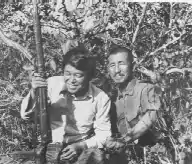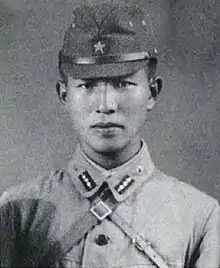Norio Suzuki (explorer)
Norio Suzuki (鈴木 紀夫, Suzuki Norio, April 1949 – November 1986) was a Japanese explorer and adventurer. In 1974 he searched for and found Hiroo Onoda, one of the last remaining Japanese holdouts who had refused to surrender after the end of World War II. Suzuki died in November 1986 in an avalanche while searching for the yeti.
Norio Suzuki | |
|---|---|
鈴木 紀夫 | |
 Suzuki and Hiroo Onoda, in February 1974 on Lubang Island. Suzuki is holding Onoda's rifle. The image was intended to be a proof that Onoda was alive. | |
| Born | April 1949 Chiba, Japan |
| Died | November 1986 (aged 37) Himalaya mountains |
| Cause of death | Avalanche |
| Nationality | Japanese |
| Alma mater | Hosei University |
| Occupation | Explorer, traveler |
| Known for | Finding Hiroo Onoda |
Early years
Suzuki was born in Chiba and lived in Ichihara. He studied economics at Hosei University, but dropped out and decided to explore the world. He toured Asia, the Middle East and Africa. In 1972, after four years of wandering the world, he decided to return to Japan and found himself surrounded by what he felt as “fake”.
Finding Onoda

Two years later, the Japanese media reported that a Japanese imperial soldier Kinshichi Kozuka, was shot to death on an island in the Philippines in October 19, 1972. Kozuka had been part of a guerilla "cell" originally consisting of himself and three other soldiers; of the four, Yuichi Akatsu had slipped away in 1949 and surrendered to what he thought were Allied soldiers; approximately 5 years later, Siochi Shimada was killed in a shootout with a local patrol on the beach at Gontin.[1] Hiroo Onoda had long since been declared dead, the Japanese authorities assuming that he and Kozuka could not have survived all these years in the jungle; they were forced to re-think this when Kozuka's body was returned to Japan. This prompted a series of search efforts to find Lt. Onoda, all of which ended in failure.[1]
Suzuki then decided to search for the officer. He expressed his decision in this way: He wanted to search for "Lieutenant Onoda, a panda, and the Abominable Snowman, in that order".[2]
In 1974, Suzuki encountered Onoda, who was wearing a tattered military uniform on Lubang Island in the Philippines. He had survived a solitary life for two years after he lost the last of his two colleagues. When Onoda was first discovered, he was ready to shoot Suzuki at first sight, but fortunately, Suzuki had read all about the fugitive and quickly said: "Onoda-san, the emperor and the people of Japan are worried about you." Onoda described this moment in a 2010 interview: "This hippie boy Suzuki came to the island to listen to the feelings of a Japanese soldier. Suzuki asked me why I would not come out..."[3]
Onoda would not be relieved of his duties unless officially ordered to do so. After extended conversations, Onoda agreed to wait for Suzuki to return with his former commanding officer (who was now an old man working in a bookstore) to give the order to surrender. Onoda said, “I am a soldier and remain true to my duties.”
In March 1974, Suzuki returned with Onoda’s former commander, who officially relieved him of his duties. Then he surrendered, was pardoned by Philippine President Ferdinand Marcos,[1] and became free to return to Japan.
Death
After finding Onoda, Suzuki quickly found a wild panda, and claimed to have spotted a yeti from a distance by July 1975, hiking in the Dhaulagiri range of the Himalayas. He married in 1976 but did not give up his quest.
Suzuki died in November 1986 in an avalanche while searching for the yeti. His remains were discovered a year later and returned to his family.[4]
References
- Hiskey, D. (2010): Today I Found Out - Feed Your Brain (February 9, 2010). Retrieved on October 8, 2016.
- Brown, P. (2010): Hiroo Onoda’s Twenty Nine Year Private War Archived 2013-12-03 at the Wayback Machine Pattaya Daily News (June 15, 2010). Retrieved on September 16, 2011.
- Willacy, M. (2010): Japanese holdouts fought for decades after WWII ABC Lateline (November 12, 2010). Retrieved on September 16, 2011.
- Sydney Morning Herald, October 8, 1987. "Yeti Hunter Dies".
Bibliography
- Echigoya, Kōji (1992). Bōkenka no tamashii: Onoda moto Shōi hakkensha Suzuki Norio no shōgai. Kōfusha Shuppan. ISBN 978-4-87519-753-9.